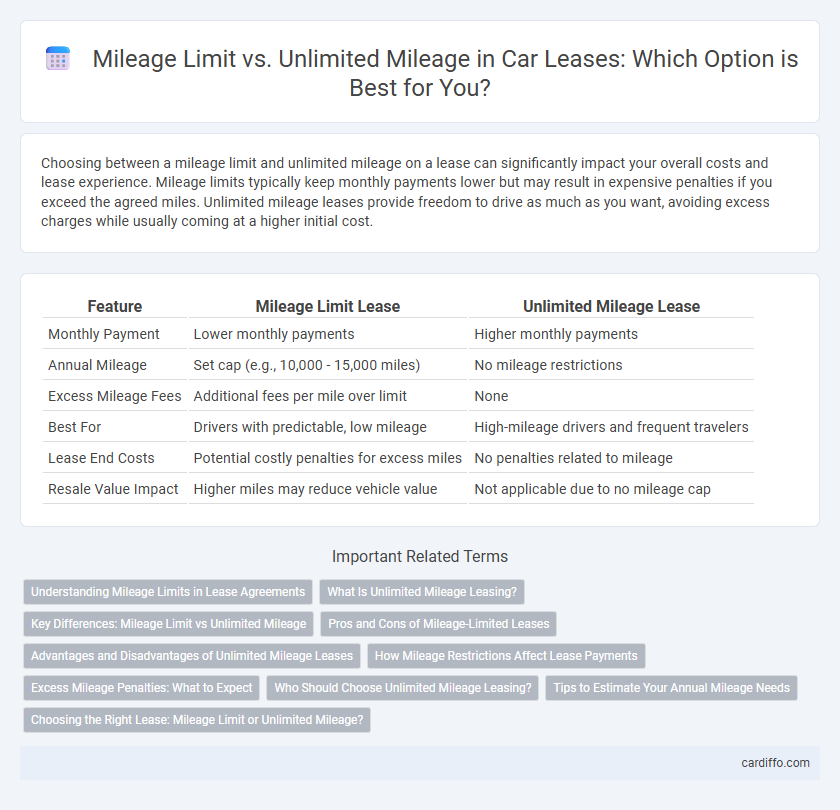Choosing between a mileage limit and unlimited mileage on a lease can significantly impact your overall costs and lease experience. Mileage limits typically keep monthly payments lower but may result in expensive penalties if you exceed the agreed miles. Unlimited mileage leases provide freedom to drive as much as you want, avoiding excess charges while usually coming at a higher initial cost.
Table of Comparison
| Feature | Mileage Limit Lease | Unlimited Mileage Lease |
|---|---|---|
| Monthly Payment | Lower monthly payments | Higher monthly payments |
| Annual Mileage | Set cap (e.g., 10,000 - 15,000 miles) | No mileage restrictions |
| Excess Mileage Fees | Additional fees per mile over limit | None |
| Best For | Drivers with predictable, low mileage | High-mileage drivers and frequent travelers |
| Lease End Costs | Potential costly penalties for excess miles | No penalties related to mileage |
| Resale Value Impact | Higher miles may reduce vehicle value | Not applicable due to no mileage cap |
Understanding Mileage Limits in Lease Agreements
Mileage limits in lease agreements typically restrict the number of miles driven annually, often ranging between 10,000 to 15,000 miles, with excess mileage charges applying for each additional mile. Understanding these limits is crucial as they directly impact the total cost of the lease, with fees that can accumulate quickly if exceeded. Choosing between a mileage limit and unlimited mileage requires evaluating driving habits and lease terms to avoid unexpected expenses.
What Is Unlimited Mileage Leasing?
Unlimited mileage leasing allows lessees to drive without restrictions on the number of miles accumulated during the lease term, eliminating excess mileage fees commonly associated with standard leases. This option is ideal for high-mileage drivers who want predictable monthly payments and no penalties for exceeding mileage limits. Leasing agreements with unlimited mileage often come with higher monthly costs but provide greater flexibility and peace of mind for drivers with extensive travel needs.
Key Differences: Mileage Limit vs Unlimited Mileage
Mileage limit leases restrict the number of miles a lessee can drive annually, typically ranging from 10,000 to 15,000 miles, with excess mileage fees applied for any overage. Unlimited mileage leases allow unrestricted driving without additional charges, offering greater flexibility and appeal for high-mileage drivers. Choosing between mileage limit and unlimited mileage depends on driving habits, with limited mileage often lowering monthly payments but potentially incurring costly penalties if exceeded.
Pros and Cons of Mileage-Limited Leases
Mileage-limited leases offer lower monthly payments and better residual value predictions, making them cost-effective for drivers with predictable, moderate usage. However, exceeding the mileage limit incurs significant per-mile penalties, increasing total lease costs and potentially causing financial strain. These leases are ideal for cautious drivers but present risks for those with uncertain or high mileage needs.
Advantages and Disadvantages of Unlimited Mileage Leases
Unlimited mileage leases provide the advantage of unrestricted vehicle use, eliminating concerns about excess mileage fees that can significantly increase lease costs. This option suits drivers with high annual mileage needs or unpredictable travel patterns, offering flexibility and peace of mind. However, unlimited mileage leases typically come with higher monthly payments compared to mileage-limited contracts, potentially making them less cost-effective for low-mileage drivers.
How Mileage Restrictions Affect Lease Payments
Mileage limits in leases directly influence monthly payments by setting a cap on the number of miles driven, typically ranging from 10,000 to 15,000 miles annually, which helps lower monthly costs. Exceeding these limits results in excess mileage fees, usually charged per mile, increasing overall lease expenses significantly. Unlimited mileage leases eliminate these restrictions but come with higher monthly payments due to the increased risk of vehicle depreciation from high usage.
Excess Mileage Penalties: What to Expect
Excess mileage penalties in lease agreements typically involve charges ranging from $0.15 to $0.30 per mile over the stipulated limit, significantly increasing the overall cost of the lease. Unlimited mileage leases eliminate these penalties, allowing unrestricted driving without additional fees, which benefits high-mileage users. Understanding the specific mileage allowance and penalty rates in a lease contract is crucial to avoid unexpected costs at lease-end.
Who Should Choose Unlimited Mileage Leasing?
Unlimited mileage leasing suits drivers who frequently exceed standard mileage limits, such as long-distance commuters or business travelers, preventing costly over-mileage fees. High-mileage drivers benefit from predictable monthly payments and reduced financial risk without worrying about excess use. This option is ideal for those requiring flexibility and extensive vehicle use within the lease term.
Tips to Estimate Your Annual Mileage Needs
Estimating your annual mileage needs accurately is crucial when deciding between a mileage limit lease and an unlimited mileage option. Analyze your daily commute, weekend travel habits, and any planned long-distance trips to avoid costly excess mileage fees or unnecessary higher lease payments. Using apps or a mileage log over a few months can provide precise data to tailor your lease agreement effectively.
Choosing the Right Lease: Mileage Limit or Unlimited Mileage?
Choosing the right lease between mileage limit and unlimited mileage depends on your driving habits and financial priorities. Mileage limit leases often offer lower monthly payments but include fees for exceeding the agreed miles, while unlimited mileage leases provide flexibility for high-mileage drivers at a higher monthly cost. Understanding your average annual mileage and potential fees helps optimize lease value and avoid unexpected expenses.
Mileage Limit vs Unlimited Mileage Infographic

 cardiffo.com
cardiffo.com